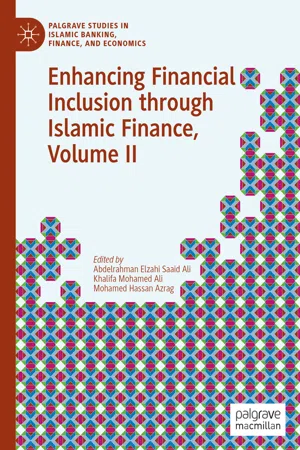Financial inclusion incorporates a range of initiatives that make financial services available, accessible, and affordable to all segments of the population, including women, youth and rural communities, and other disadvantaged groups (A Elzahi Saaid Ali (2019)). Recent initiatives from the international development institutions, United Nations, and G-20 showed that financial inclusion is an important element in the formulation of the Sustainable Development Goals (SDGs), the new development architecture that succeeds the Millennium Development Goals (MDGs), and The Millennium Development Goals Report (2015). Financial inclusion could play an important role in the fight against poverty and help in achieving inclusive development. Moreover, recently financial inclusion has become one of the main drivers in the reform and development agendas of multilateral institutions such as the World Bank, African Development Bank, and Islamic Development Bank (IsDB).
Providing access to finance has been challenging all over the world, particularly among the 57 member countries of the IsDB. The Arab Spring and political instability in parts of the Middle East and North Africa (MENA) region and other member countries exposed the IsDB member countries to the risk of poverty, hunger and inequality, and difficulty in accessing decent employment. There is also the urgent need for fostering economic growth, good health services, and well-being, as well as addressing gender equality issues. Financial inclusion is a very essential element that can mitigate the above-mentioned risks. These two books (Volumes I and II) explore financial inclusion from the Islamic perspective to promote inclusive growth in IsDB member countries and help in mitigating poverty, reducing inequality, and improving access to decent employment.
Unlike in the conventional perspective of financial inclusion, Islamic financial inclusion goes beyond access to finance. It encompasses enhanced access to savings and risk mitigation products, as well as social inclusion that allows individuals and companies to engage more actively in the real economy. It represents one of the important drivers of economic growth. Access to finance is one of the most formidable challenges confronting micro-entrepreneurs and the poor in IsDB member countries. Given the high poverty among low-income groups and the unavailability of collateralization mechanism, lending to these groups is normally associated with greater risk. Considering these challenges, the IsDB initiated and successfully implemented programs promoting Islamic microfinance in its member countries such as Sudan, Yemen, and Bangladesh. The two books are the first in the market to address Islamic financial inclusion and to provide empirical evidence and modeling. It is expected that the two volumes will be well received among university students and instructors, especially in the IsDB member countries and beyond.
In addition to the rising poverty and unemployment, most IsDB member countries are facing a huge gap in gender equality. The gender gap varies widely across economies and regions. Among the regions, South Asia and the Middle East and North Africa have the largest gender gaps. These regions comprise of about 40% of women who are less likely to have a formal account than men (The Global Findex Database 2013). Hence, financial inclusion is essential, and will be successful and effective if correctly used to find ways of harnessing the untapped potential of those disadvantaged individuals currently excluded from the formal financial sector or not fully served by the available products and services. Innovation in women- and youth-specific Islamic financial inclusion products would be good enough to mitigate the gender gap.
Since the last quarter of the last century, Islamic economics and finance has contributed significantly to the development of financial sectors and, deepening financial...
